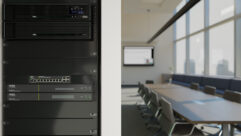
KVM Switches Answer Call to AV/IT Action
May 22, 2008 3:43 PM,
By Jessaca Gutierrez

AdderView CATx 1000
A staple among devices in the server room, the KVM switch is garnering a bit more attention on the AV side of the networking platform. Traditionally, the KVM switch was developed to manage the burgeoning crowd of CRT monitors, keyboards, and mice. Early models of the switch connected these devices to two desktop workstations. Later, however, innovation took hold and KVM switches become the control tool for racks of servers. The value-add of such a tool was its ability to conserve precious rack space while still managing a growing number of LAN and WAN applications.
Space, like anything else in the IT/AV environment, is a valuable commodity, especially in small control/server quarters. And with that prolific networking backbone becoming fast the control feature of many AV products—such as high-resolution displays for digital signage, videoconferencing suites, videowalls, and informational kiosks—the market value on that space goes up and the call for more rack-friendly products become ever more fruitful. Having a device to control it all, without sucking up space both on the server and on the rack, means something in the world of AV/IT integration. And that’s where KVM switchers have stepped up to become multipurpose tools in the control shed—where all the real magic behind AV control happens.
When Cyberoam purchased its previous KVM switcher before purchasing the Adder
KVM the company’s IT department uses now, it was hardly used because of its complex and bulky cabling and the space drain the unit’s installation software required.
“The beauty of the CATxIP KVM switch is that it works just like a typical Ethernet switch,” says Joseph Guan, IT manager for Cyberoam. “In our situation, I manage multiple MULTOS servers that hosts our most critical servers in a remote data center with the CATxIP KVM switch with ease.”

At Interop Las Vegas 2008, Adder released its AdderView CATx 1000 KVM switch to provide a central control point for up to 16 multiplatform servers, and it can easily be expanded to support up to 256 computers, all in a small desktop form factor. As more and more corporations dive into creating and providing rich digital content, from digital signage to videowalls and interactive kiosks, tools such as the CATx 1000 is delivering the video quality consumers in the digital age require, but with a something little extra: audio.
“The CATx 1000 provides exceptionally high video performance to both local and remote users and supports CD-quality 44.1kHz digital stereo audio, which is ideal for digital signage applications,” says Adder Marketing Manager, Heather Santos. “The CATx 1000 also supports RS-232 for use with control and automation systems such as Crestron and Extron.”
That ever-shrinking divide between IT managers and AV integrators will probably both appreciate the size of the units, but it’s the integrators that will cherish the RS-232 support of the product. The 8-port AdderView CATx 1000 carries a list price of $495 and the 16-port AdderView CATx 1000 carries a list price of $645; both units are currently shipping.
This month, Tripp Lite also announced additions to its line of KVM switches. The 16-Port Tripp Lite NetCommander B072-016-1-IP Cat-5 KVM switch is a 1RU unit that features onboard IP remote access.










